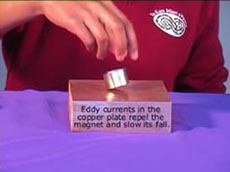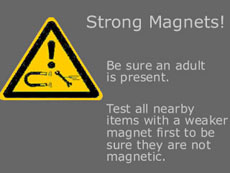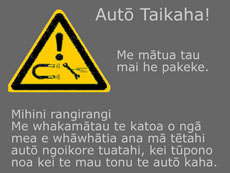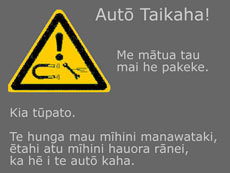Eddy Current – Drag | Papa Konukura
Introduction
Abstract
A strong rare Earth magnet and slabs of copper illustrate electromagnetic induction and eddy currents in dramatic fashion.
Principles Illustrated
Eddy Currents: A magnet sitting on or near a non-magnetic conductor such as copper experiences no force. But if the magnet is moved near a conductor (here a copper slab) swirling eddy currents are induced in the conductor. These eddy currents interact with the magnet resulting in a drag force that slows the fall of a magnet toward the copper slab and causes other unexpected motion such as a slow tumble down a copper slab at an angle.
Newton’s Third Law: The interaction between the eddy currents and the magnet drag the copper slab result in a force on the copper slab in the direction that the magnet is moved. This seems surprising at first.
Content
Video
English version
Te Reo Māori Version
Instructions
Students like this demonstration because it seems like magic and yet can be understood qualitatively even by students in junior science. The interaction force between the eddy currents and the magnet is large enough to be obvious only with very strong magnets. These are rare earth magnets model N42 from MacMill Magnets. It is essential to use thick slabs of copper to maximize the effects as only those field lines cutting through the copper will contribute. Aluminium works poorly as it is not a good enough conductor. Unfortunately these copper slabs are rather pricey. Ours are 15 cm x 15 cm x 5 cm and 50 cm x 10 cm x 1.2 cm. Most motion of the magnet near the copper slabs will result in a drag force. Our favourite is the slow tumble (see video) and the drag force on the copper slab on rollers (whiteboard pens). But just play with the magnet and find some cool effects. See the worksheet for some examples. Once stuck together they are very hard to get apart. The fake magnet is a stainless steel cylinder made in the Victoria University School of Chemical and Physical Sciences Machine Shop. The fake magnet is not essential – any non magnetic metal will serve the purpose, showing that the eddy currents are only generated by moving a magnet.


Other Information
Safety
You really can get a serious injury from large rare Earth magnets. They will fly toward another magnet or even a steel object and will be moving fast enough to shatter when they hit. The chunks that fly out of these collisions tend to have sharp edges. You don’t want to get your fingers between the magnet and some steel! See the video for an example collision. People with pacemakers or other medical electronics should never approach these very strong magnets! Swallowing a rare Earth magnet is particularly dangerous and they need to be kept away from small children.
Individual teachers are responsible for safety in their own classes. Even familiar demonstrations should be practised and safety-checked by individual teachers before they are used in a classroom.




Related Resources
We have lots of eddy current resources. See in particular Eddy Current Tank.
Notes, Applications, and Further Reading
Eddy current drag is used to make brakes in certain applications. See for example the following exchange on physlink: eddy currents brakes. Also see a discussion of eddy currents in Wikipedia.
Credits
This teaching resource was developed by the Te Reo Māori Physics Project with support from
- Te Puni Kōkiri
- The MacDiarmid Institute
- Faculty of Science, Victoria University of Wellington
- School of Chemical and Physical Sciences, Victoria University of Wellington
- The New Zealand map shown on the poster frame above is used with permission from www.nz.com.
- The strong magnets were supplied by the Magnetic Resonance Physics research lab founded by the late Prof. Paul Callaghan. His lab is still operating and is located on the Victoria University of Wellington campus.